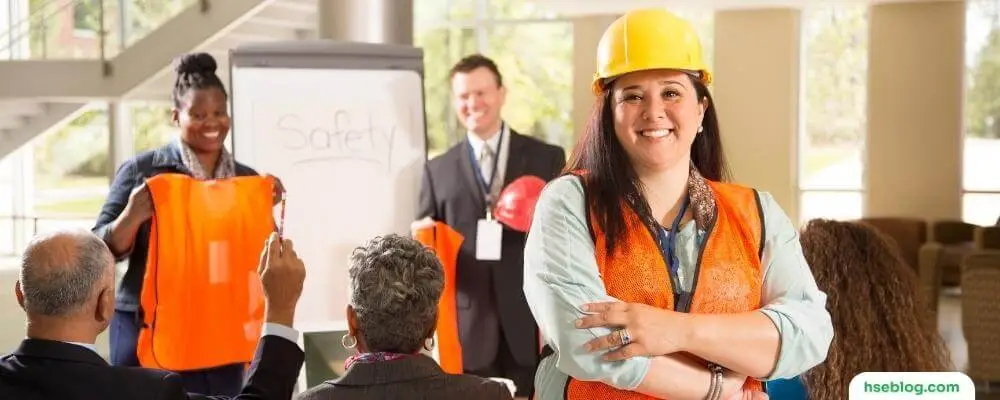Safety and security are two concepts often used interchangeably, but they differ. While both are critical for protecting individuals and society, they have distinct goals, approaches, and impacts. This blog post will explore the 10 major differences between safety and security. From their definitions to their responsibilities, scope, and timeframes, we will dive into the unique characteristics of each concept.
By understanding these differences, individuals, organizations, and governments can better address safety and security risks and take necessary measures to prevent harm. Whether you are a worker in a high-risk industry, a business owner, or a concerned citizen, this post will help you understand the important distinctions between safety and security.
What is Safety?
Safety can be defined as the state of being free from harm or danger. It includes measures to protect people from accidents, injuries, and exposure to hazardous conditions. Safety is often achieved through the implementation of safety procedures and protocols. These procedures are designed to minimize the likelihood of an accident or injury occurring.
Why is Safety Important?
Safety is crucial because it helps protect people from accidents and injuries. Safety procedures and protocols can help prevent accidents from happening, and they can also help reduce the severity of injuries if an accident does occur. Safety is also essential because it helps create a work environment free from hazards. This can improve employee morale and productivity and reduce the number of workers’ compensation claims filed.
What is Security?
Security can be defined as being protected from crime, violence, or other harm. It includes the measures taken to protect people from theft, vandalism, terrorism, and other threats. Security is often achieved through the implementation of security procedures and protocols. These procedures are designed to deter criminals and reduce the likelihood of a crime or act of violence occurring.
Why is Security Important?
Security is essential because it helps protect people from crime and violence. Security procedures and protocols can deter criminals’ activities and help reduce the acts of violence occurring. Security is also important because it helps create a work environment that is safe and secure. This can improve employee morale and productivity and reduce the number of insurance claims filed.

Differences Between Safety And Security | 10 Major Differences
One of the most important aspects of security is that it is proactive. This means that security measures are taken in anticipation of potential threats. Safety, on the other hand, is more reactive. This means that safety measures are put in place after an incident. Here are 10 major differences between safety and security:
1. Definition Aspect
The key distinction between safety and security lies in their respective definitions. While security mainly pertains to safeguarding against potential external threats that can cause harm, it can also encompass physical safety or financial stability for individuals and organizations. On the other hand, safety is predominantly focused on protecting individuals and organizations from physical dangers.
In simpler terms, security is concerned with protecting against intentional harm caused by external factors, such as theft or cyberattacks, while safety is focused on preventing unintentional harm caused by physical hazards, such as accidents or natural disasters.
2. Prevention Aspect
Another aspect to consider when comparing safety and security is their approach to prevention. Typically, safety measures are implemented beforehand to prevent accidents or injuries from occurring. In contrast, security measures are usually put in place in response to criminal activity or violence that has already taken place.
In other words, safety primarily focuses on proactively identifying potential risks and hazards and taking measures to prevent them from causing harm. Security, on the other hand, is often reactive, responding to threats and breaches after they have occurred.
3. Emotional Aspect
The emotional aspect of safety and security is also worth considering. Safety is often associated with positive emotions, such as peace of mind, while security is typically associated with negative emotions, such as fear and anxiety.
Both safety and security are essential for any business to operate effectively. Safety measures help to prevent accidents and injuries, while security measures help to prevent criminal activity and violence. Together, they create a safe and productive work environment for employees and protect the public from any harm resulting from negligence or carelessness on the part of company staff.
A business can protect its employees and assets by implementing safety measures such as fire alarms and safety protocols and security measures such as surveillance systems and access control. This ensures that everyone involved in the business, including customers and visitors, can feel secure and confident in their safety while on the premises.

4. Goal Aspect
The goal of safety is to mitigate or prevent accidents and injuries from happening. Safety measures are implemented to minimize risks and hazards, and people can go about their business without fear of harm.
In contrast, the primary goal of security is to deter criminal activity and violence from occurring. Security measures are implemented to prevent unauthorized access, theft, vandalism, or any other malicious activities that may cause harm to people or property.
While safety and security may have different goals, they are complementary. By prioritizing safety and security, a business can create a safe and secure environment that fosters productivity and well-being for all individuals involved.
5. Deliberate and Unintended
The difference between safety and security can also be described in their focus on deliberate versus unintended threats. Security involves deliberate protection against potential threats, while safety focuses on unintentional protection against threats.
Organizations intentionally implement security measures to safeguard against various threats, including terrorism, theft, espionage, and natural disasters. Physical and cyber security measures are implemented to deter, detect, and defend against these potential threats. Physical security measures include barriers, surveillance systems, and security procedures, while cyber security measures aim to protect electronic information and systems from unauthorized access or damage.
On the other hand, safety measures are implemented to prevent unintended harm or accidents. For example, in workplaces that handle chemicals, individuals must wear safety clothing to protect them from potential accidents. Safety measures aim to minimize the risk of harm from unintentional hazards, such as slipping, falling, or exposure to harmful substances.

6. Coverage
The security scope is much wider than that of safety and can even extend internationally. Governments are responsible for ensuring the security of their citizens by implementing security measures at borders and in airspace. Terrorism, on the other hand, is often considered a domestic issue, as it is typically carried out by individuals or groups within a country or region.
While safety measures are essential for protecting individuals and organizations from physical harm, security measures cover a wider range of areas, including physical security, cyber security, and national security. Physical security measures such as locks and alarm systems are designed to prevent unauthorized access, while cyber security measures aim to protect against online threats and data breaches. National security measures, such as border control and military defence, are put in place to safeguard a country’s sovereignty and protect its citizens from external threats.
Terrorism can take many forms, and it can be aimed at civilians or government targets. It can be driven by religious, political, or economic motivations. Despite the different types of security and the various forms of terrorism, safety and security are complementary. Without security, safety cannot be guaranteed, and without safety, security measures may be insufficient to protect individuals and organizations from harm.
7. Responsibility
Regarding safety, individuals are often responsible for their well-being and those around them. For example, when driving a car, individuals are responsible for following traffic rules, wearing a seatbelt, and avoiding distractions. Similarly, when at home, individuals are responsible for ensuring that their environment is free from hazards such as fire risks or tripping hazards.
On the other hand, security is typically the responsibility of an organization or government. Organizations may implement security measures to protect their assets and people from intentional harm, such as installing security cameras, employing security guards, and implementing access control systems. Similarly, governments protect citizens from security threats such as terrorism, cyber-attacks, and crime.
8. Approach
The approach to addressing safety and security risks differs significantly. Safety is often addressed through education and training programs that aim to raise awareness about potential hazards and how to avoid them. This approach helps individuals to understand the risks they face and take necessary precautions to prevent accidents. For example, safety education and training programs can teach people how to use equipment safely, avoid slips, trips, and falls, and respond to emergencies such as fires or natural disasters.
In contrast, security risks are often addressed through technology and security measures. This approach involves implementing measures against intentional harm, such as physical security barriers, surveillance cameras, and access control systems. Technology and security measures are often designed to prevent or deter unauthorized access or actions that could cause harm. For example, a bank may install a security camera to deter robbers, or an airport may use metal detectors to prevent passengers from bringing weapons onto planes.

9. Timeframe
One of the major differences between safety and security incidents is the timeframe in which they occur. Safety incidents can happen at any time and are typically the result of accidents or unexpected events. For example, slips, trips, and falls can happen at any time and are often the result of human error or environmental factors such as wet floors or uneven surfaces. Similarly, natural disasters such as earthquakes or hurricanes can occur without warning and cause significant harm.
In contrast, security incidents are often planned in advance and may take time to execute. Threats such as terrorism, cyber-attacks, or theft are typically planned and executed over a longer timeframe than safety incidents. For example, a terrorist organization may spend months or even years planning an attack, gathering intelligence, and developing a plan of action. Similarly, a cybercriminal may spend weeks or months researching vulnerabilities in a network before launching an attack.
10. Types Of Threats
The types of threats that safety and security address are also different. Safety threats are typically related to accidental harm and natural disasters caused by environmental factors, human error, or equipment failure. Examples of safety threats include slips, trips, falls, burns, electrocution, explosions, or natural disasters such as earthquakes, floods, or hurricanes.
In contrast, security threats are typically related to intentional harm caused by human actions, such as crime, terrorism, or cyber-attacks. Security threats can target individuals, organizations, or governments and have serious consequences, such as theft, physical harm, or compromising sensitive information. Examples of security threats include theft, vandalism, assault, kidnapping, cyber attacks, terrorism, or espionage.

Safety and Security Examples
There are many different types of safety and security examples that you can use in your home, office, or business. You can better protect yourself and your property by understanding security measures.
Whether you are looking for a burglar alarm system or ways to prevent identity theft, there are plenty of options. Here are a few of the most common safety and security examples you can use to keep yourself safe.
Safety Examples
Security Examples
Security is critical in all industries to protect against cyberattacks, theft, and fraud. Companies must implement effective security measures to protect their assets and safeguard their operations. A few security examples are:
Security Examples In Different Industries

Safety Examples In Different Industries
Safety measures are critical in all industries to protect workers, customers, and the general public from harm. Each industry has unique safety concerns and protocols, and employers and workers need to be aware of these measures and take necessary precautions to ensure safety.
Conclusion
Safety and security are two distinct concepts that are critical in protecting individuals and society. Safety concerns accidental harm, while security concerns intentional harm. The goals, scope, responsibility, approach, timeframe, types of threats, and safety and security regulations are different. Understanding these 10 major differences is crucial for individuals, organizations, and governments to effectively address safety and security risks.
While safety is often addressed through education and training, security is often addressed through technology and security measures. By implementing appropriate measures and taking necessary precautions, we can minimize the impact of safety and security incidents and ensure the well-being of ourselves and those around us.

